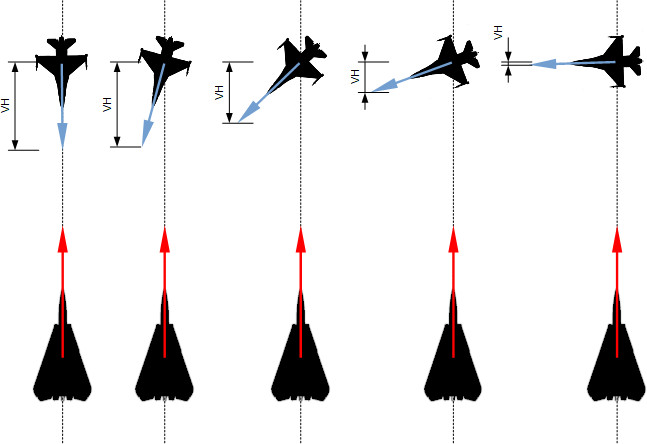In this video I went through some of the basics of the RIO role such as the managing the Antenna Elevation, Mainlobe Clutter, how to counter Notching and TWS. In this article I will go a bit more into the details of some of these topics, especially countering Notching.
Antenna Elevation and TWS
I have discussed the Antenna Elevation and the elevation model I made in two articles. The video shows how to use the table resulting from the model and why it is important at 1:49: two targets approaching, the altitude difference is considerable and the radar can’t illuminate both of them unless the antenna elevation is changed. In this scenario the easiest solution is pushing TWS ±20°, 4 BARS but that is not always possible. Adjust the elevation then is very important to allow different radar settings whilst maintaining the targets on the radar.
I discussed the TWS limitations elsewhere already and these are the two most important points to remember:
- TWS is limited to ±20°, 4 BARS or ±40°, 2 BARS because it requires a full sweep every two seconds in order to build tracks.
- TWS Auto is not implemented yet but the WCS pushes it automatically after firing. Since it resets the antenna, you might lose your missile. The easiest solution is maintaining the target within the azimuth and the elevation of the default radar cone (ergo ELEV=0 and AZM=0) and quickly push TWS Manual.
Notching
“Notching” is a basic defensive manoeuvre against a lock and I briefly discussed how to counter it at 7:58. Not let’s see some more details.
Notching takes advantage of an intrinsic gap in the Pulse Doppler radar. In order to understand why this happens, we should spend some time learning how a Pulse Doppler Radar works and at least the basics of the Doppler effect. Since this is well beyond the purpose of this article, I refer you to Wikipedia and to the many other sources you can find online.
For the sake of this discussion, we can simply say that the Doppler effect is the reason why, for instance, the pitch of F1 cars engines is much higher when they are approaching rather than when the car is receding and this happens because it is the relative difference in velocity that creates the Doppler effect.
We can therefore conclude that a target that is moving perpendicularly to our radar antenna has a relative speed equal to zero. This target is, in fact, notching.

Other radar modes, such as Pulse of CW use different principles and effects so they don’t suffer from the notching issue. As you can image though, they have other issues or we would be constantly using other radar modes.
The Pulse Radar, along with the Continuous Wave Radar are the ancestors of the Pulse Doppler Radar. As the PD, the Pulse works by emitting pulses and then waiting for the returns. Very simply put, since the Pulse radar doesn’t use the Doppler effect, it is subject to almost any return, ground included. That’s why the Pulse Search radar function of the AWG-9 can be actually used as a very basic ground mapping radar. In Pulse mode even notching targets return signals thus they can be tracked and locked. In more practical terms, it means that from the RIO seat can find, lock and engage a notching target with an AIM-7 Sparrow (and not only that) as I did in the video at 16:26. This techniques works surprisingly well as long as we are in a look up – shoot up situation. Ground returns in fact can disrupt the lock or prevent us to lock at all because the Pulse mode have hard time distinguishing between the target and the ground returns.
But not all is lost for the PD! The RIO in fact can still say a thing or two to notching targets even by means of the PD radar (which allows for the full use of the AIM-54 capabilities). Some advanced features and control of the DDD panel are not fully implemented yet but some are and the Mainlobe Clutter filter is one of them: the purpose of the MLC is to filter unwanted returns, especially from the ground, thus allowing the radar to be used in a look-down situation.
The RIO can disable the MLC filter and improve the detection of zero relative velocity targets. Disabling the MLC works very well in a look-up situation but not in a look-down situation. In the latter situation there are high chances that false, unfiltered, returns are processed by the WCS, increasing the load on the computer and saturating the limited amount of TWS tracks.
I shown the effect of disabling the MLC at 10:18.
Mr Karon, I don’t feel so good
Too many information and your brain is about to blow up? No worries, let’s wrap it up with a shorter and simpler recap:
- A Notching aircraft is an aircraft flying perpendicularly to the radar emitter, therefore blinding Pulse Doppler Radars;
- The Mainlobe Clutter filter is implemented to avoid unwanted returns in PD mode. The MLC can be disabled in order to spot and lock notching targets especially if they are flying at your same altitude or higher;
- The Pulse radar is not affected by Notching but the ground returns can prevent a successful lock.
Sidenote: The TCS can be useful as well, but this is material for another article.
As we have seen, if you can eliminate the ground factor, there are really effective ways to deal with a notching aircraft to the point that the AWG-9, operated by a good RIO and in the correct situations if fundamentally un-notchable.
The best way to find out the limits and situations where each solution is more appropriate is testing, so go set up some scenarios in the Mission Editor!
